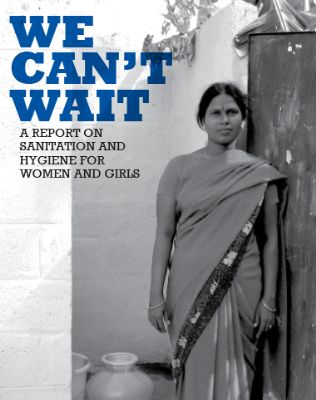
Why We Can't Wait - report cover photo (Wikipedia)
But we seem to have institutionalized the disparity in ways completely unnecessary and impractical. Despite women outnumbering men in much of the western world and in many nations also being better educated on average than their male counterparts, we pay them significantly less and offer them far fewer promotions and high leadership positions than we do men.
Many guys think even today that women's place is just in the home, preferably "barefoot and pregnant." Perhaps it is one reason that in a most fundamental way, removal of our bodily wastes, the opportunities for men and women outside their own houses remain unequal.
All my life I have seen that the lines for public restrooms at entertainment events or travel stops are longer for women than men. Why could not the designers of such facilities add extra toilets in ladies restrooms, taking into account that it requires a little longer for a woman to sit down to do her business than for a man to merely point and shoot?
 Why We Can't Wait - report cover photo (Wikipedia) |
Excretory conditions for women are thus hardly ideal in this country. Elsewhere, however, they can be extremely primitive. In India, for example, lack of women's hygiene facilities is at crisis levels. While men there are sometimes allowed to go in the open against any odd wall in the street, hundreds of millions of ladies and girls in Indian cities must do without toilets even when in school or working long hours, and then, still miles from their living quarters, may be assaulted by men late at night when finally able to seek relief.
Holding instead of urinating periodically or defecating when needed causes women serious health problems, including infections and diarrhea, which, with limited medical care as well, can lead to illness or death. The male dominated Indian authorities will not acknowledge such problems, in fact contending that since women rightfully are neither in schools nor jobsites but properly are looking after the children and homes, there can be no such shortages.
For people unfamiliar with the extent of the problem, perhaps insulated by the common male experience or by ignorance of conditions in Third World countries, these comments might seem like hyperbole. Nonetheless, a quick perusal of the articles and report at the links below will show that, if anything, I have touched too lightly on the extent of the tragedy.
Besides concerns of peace of mind, convenience, personal safety, and clear health aspects involved in lack of adequate access by women to plentiful, clean, easily accessible, and properly supplied bathroom facilities, it is a severe economic drain that such necessities are too often not available. One example: just as distracted drivers are hardly as safe on the road as those without such attention liabilities, millions of women at the worksite, for hours urgently needing to urinate or defecate yet required to remain at their posts, are certainly not as well focused on their tasks or customers as those who can relieve themselves in a more leisurely and natural way.
Action is needed now:
Charities, such as the Bill and Melinda Gates Foundation, may also be enormously helpful in moving things forward. We now live, after all, in the 21st Century. Let us all get on board and lead the provision of bathroom facilities for women out of the Dark Ages.
Primary sources:
Tackling Sanitation for Women's Health. in Unilever; November 19, 2013;
The Lack of Equal Access for Women is a Global Design Flaw. Laura Bliss in The Atlantic; November 7, 2014;
We Can't Wait: A Report on Sanitation and Hygiene for Women and Girls. in Water Aid - Unilever; November 19, 2013.